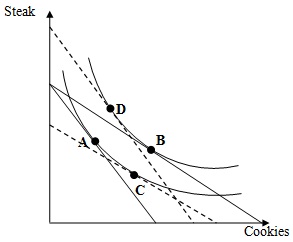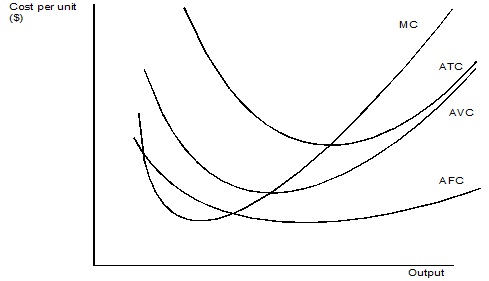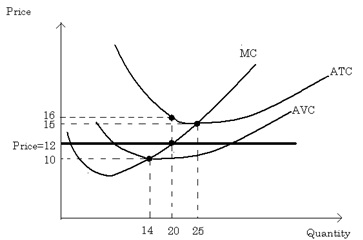Binary Choice:
Problem 1. In Mexico suppose the CPI in 2007 is 100 while the CPI in 2008 is 95. This is an example of
a. Inflation.
b. Deflation.
Problem 2. Suppose a consumer buys two goods: cheese and milk. The consumer has a downward sloping income-consumption line for the two goods. This implies ________.
a. Either Cheese or milk is an inferior good.
b. Both products are inferior goods.
Problem 3. As a firm increases the quantity it produces in the short run, the average variable cost curve moves closer and closer to the
a. average fixed cost curve
b. average total cost curve
Problem 4. Suppose a firm produces in the short run with the price of all inputs constant. In the short run, diminishing marginal returns implies that this firm’s
a. Marginal cost increases as additional units of the variable input are hired
b. Average total cost increases as additional units of the variable input are hired.
Problem 5. The following describes 2 different markets. Which of these markets most closely resembles a perfectly competitive market?
a. Market A: The good sold in this market is a homogenous good. Firms can easily enter and leave the industry. There are a large number of buyers and a large number of sellers. The firms set their own price to maximize their economic profit. The price charged by each firm varies as does the marginal cost curve for each firm.
b. Market B: The good sold in this market is a homogenous good. Firms can easily enter and leave the industry. There are a large number of buyers and a large number of sellers. No buyer or seller has a large market share. The price of the good is constant when there is no entry or exit in this market.
Problem 6. If the price of coffee decreases by 20%, Amy’s demand for cheesecakes increases by 15%. From Amy’s perspective, coffee and cheesecake are
a. Complements
b. Substitutes
Problem 7. A “extremely bowed inward” set of indifference curves represents the two goods as
a. Very close substitutes.
b. Very close complements.
Problem 8. The market for pens is perfectly competitive. Suppose the price of pens is currently above the long run equilibrium price. Which of the following statements is true?
a. Firms will enter the market in the long run because they can earn positive profit in the current market.
b. Firms will make negative profits because consumers will not purchase pens at a price above the long run price.
Problem 9. In a perfectly competitive market, every seller faces a completely flat demand curve. Therefore, no seller can affect the equilibrium price for the good.
a. True
b. False
Problem 10. Economic profits are ________ accounting profits.
a. at least as large as
b. no bigger than
Problem 11. Price and total revenue are negatively related when __________.
a. Demand is elastic.
b. Demand is inelastic.
Problem 12. If there are increasing returns to scale for a firm, then the long run average total cost curve
a. Is upward sloping as output increases.
b. Is downward sloping as output increases.
Multiple Choice Section
Use the following information to answer the next 4 questions.
Hint: this set of questions is challenging and you may want to solve all the questions on the exam before working through this set of questions.
The short run total cost function of a representative firm in a perfectly competitive market is given by the equation TC = 100 + q2, where q denotes the units of output produced by the firm. The implied short run marginal cost curve for a representative firm is therefore MC = 2q. Assume the market demand is given by P = 300 – Q where the market quantity demanded is Q.
Problem 13. Suppose that there are 3 firms in the market. What is the short run equilibrium price in the market?
a. $40
b. $60
c. $80
d. $120
Problem 14. Suppose the price of the good in the market is $40. Given this market price, what is the profit each firm earns?
a. $120
b. $150
c. $240
d. $300
Problem 15. Suppose this perfectly competitive industry is in long run equilibrium. How many firms are in this industry when the industry is in long run equilibrium?
a. 12 firms
b. 15 firms
c. 28 firms
d. 30 firms
Problem 16. (Warning: this is a question that you need to think hard about before you start to answer it: thinking through the intuition will save you a lot of time.) Suppose the government places a $30 excise tax on this good. After the imposition of the excise tax, suppose the industry returns to long run equilibrium. What will be the breakeven price and profit maximizing quantity for each firm in the industry under long run equilibrium?
a. P=$30, q=6
b. P=$40, q=6
c. P=$40, q=8
d. P=$50, q=10
Use the following information to answer the next 2 questions:
Amy likes to eat steak and cookies for lunch. Each day, she has a fixed budget for lunch. The graph below illustrates Amy’s utility maximization problem. In the graph the solid straight lines represent Amy’s possible budget lines, while the dotted lines represent imaginary budget lines (or income compensated budget lines).

Problem 17. Assume the price of cookies decreases from its original level. The income effect is represented by
a. A movement from D to A.
b. A movement from D to B.
c. A movement from A to D.
d. A movement from C to B.
Problem 18. After some time passes suppose that the price of cookies increases back to its original level. The substitution effect of this second price change (the increase in the price of cookies) is represented by
a. A movement from B to C.
b. A movement from B to D.
c. A movement from A to C.
d. A movement from C to D.
Use the following graph to answer the next question.

Problem 19. Which of the cost curves drawn above are incorrectly drawn?
a. marginal cost
b. average total cost
c. average variable cost
d. average fixed cost
Use the following information to answer the next 3 questions:
Allen has a weekly income of $400 and spends all of his income on two goods: potatoes and rice. If he spends all of his income on potatoes, he can buy 100 pounds of potatoes. If he spends all of his income on rice, he can buy 80 pounds of rice.
Problem 20. If Allen consumes 24 pounds of rice at his optimal consumption bundle, he also consumes
a. 84 pounds of potatoes.
b. 76 pounds of potatoes.
c. 70 pounds of potatoes.
d. 65 pounds of potatoes.
Problem 21. If Allen’s income decreases by $40 and potatoes are an inferior good for Allen, other things being equal, then at Allen’s new optimal consumption bundle the quantity of rice Allen consumes
a. Will increase.
b. Will decrease.
c. Will remain the same.
d. May increase or decrease.
Problem 22. Suppose Sarah faces the same prices as Allen and her indifference curves for these two goods are downward sloping and obey the set of properties for typical indifference curves. At her current optimal consumption bundle, Sarah’s marginal utility for the last unit of potatoes consumed is 5 and her marginal utility for the last unit of rice consumed is 4. Which of the following statements is true?
a. If Sarah spends all her income, she is consuming her optimal consumption bundle.
b. Sarah is not consuming her optimal consumption bundle and should consume more rice.
c. Sarah is not consuming her optimal consumption bundle and should decrease her consumption of both rice and potatoes.
d. Sarah is not consuming her optimal bundle and should consume more potatoes.
Problem 23. In the short run, all of the following are fixed costs of production except
a. factory infrastructure
b. purchased vehicle fleet
c. electricity
d. property taxes
Use the following graph to answer the next 2 questions.
The graph below shows the cost curves for coffee beans for a representative firm in the coffee bean market. Assume the market is perfectly competitive and the market price is currently $12.

Problem 24. Given the above graph, this firm’s current total revenue equals
a. $375
b. $300
c. $240
d. $140
Problem 25. Given the above graph, this firm’s current economic profit equals
a. $240
b. $80
c. $0
d. $-80
Use the following table to answer the next 3 questions.
# of workers Quantity of Output Total Cost
0 0 400
1 50 420
2 65 430
3 75 460
4 80 485
5 82 500
Problem 26. Suppose that in the short run the market equilibrium price is $6, what is the profit maximizing quantity?
a. 50
b. 75
c. 80
d. 82
Problem 27. When output sells at a price of $6, this firm will choose to:
a. continue to produce in both the short run and the long run
b. continue to produce in the short run and exit from the market in the long run
c. continue to produce in the long run and shut down in the short run
d. shut down in the short run and exit in the long run
Problem 28. Between 2 units of workers and 5 units of workers, the firm experiences:
a. Economies of scale
b. Decreasing Return to scale
c. Increasing Return to scale
d. Diminishing Marginal returns
Problem 29. A 10 percent increase in income increases the demand for cheese by 5 percent. Given this information the income elasticity of demand for cheese is _____, and cheese is a(n) _____.
a. 2; normal good.
b. 0.5; normal good.
c. 2; inferior good.
d. 0.5; inferior good.
Problem 30. Suppose the price elasticity of demand for rice is 0.5, while the cross-price elasticity of demand between rice and potatoes is 0.7. Holding everything else constant, if the price of rice increases by 40%, the demand for potatoes will
a. increase by 20%
b. decrease by 20%
c. increase by 28%
d. decrease by 28%
Problem 31. Suppose Kristina decides to quit her $40,000 a year job to start her own company. In order to pay for the initial investment, Kristina takes out a loan of $100,000 which will incur an interest payment of 10% each year. Assume this interest payment is not included in Kristina’s operating expenses. In its first year, Kristina’s company generates sales revenue of $200,000 and its operating expenses are $80,000. Given this information, what is Kristina’s economic profit for the first year?
a. $90,000
b. $70,000
c. $80,000
d. -$30,000
Use the following information to answer the next 2 questions.
Year CPI (BY= 1990) CPI (BY = 1980)
1980 50
1990 100 A
2000 125
2009 150 B
Problem 32. Solve for A and B respectively.
a. 100, 250
b. 200, 300.
c. 100, 300
d. 200, 250
Problem 33. Suppose your nominal salary was $50,000 in 2000. What is the minimum nominal salary you must receive in 2009 in order for you to maintain the same real salary/purchasing power you had in 2000?
a. $57,500
b. $60,000
c. $62,500
d. $65,000
Use the following information to answer the next 2 questions.
Ben consumes two goods, X and Y. Ben’s Budget Line is given by X = 8 – 4Y. Assume that X is on the horizontal axis and Y is on the vertical axis. Goods X and Y are perfect substitutes for Ben. 1 unit of Y is equivalent to 2 units of X.
Problem 34. What is Ben’s optimal consumption bundle?
a. 8 units of X and 0 units of Y
b. 0 units of X and 2 units of Y
c. 0 units of X and 4 units of Y
d. 4 units of X and 1 unit of Y
Problem 35. Suppose the price of good X triples. What is the substitution effect of that price with respect to Ben’s consumption of good X?
a. 0 units of X
b. 2 units of X
c. 4 units of X
d. 8 units of X
Problem 36. Suppose the supply curve for a good is perfectly elastic while the demand curve for that good is a typical downward sloping demand curve. The economic incidence of a $10 excise tax levied on this good and legally paid by sellers will fall on
a. The sellers only.
b. The buyers only.
c. Both buyers and sellers: they will share the economic burden of the tax.
d. Neither buyers nor sellers: they will not bear the economic burden of the tax.
Problem 37. Assume demand in the market for potatoes is linear. Suppose that the price of potatoes increases from $2 a pound to $3.50 a pound. The price elasticity of demand between these two prices on the demand curve for potatoes, calculated using the midpoint method, is unit elastic. At what price will the revenue from selling potatoes be maximized?
a. $2
b. $2.60
c. $2.75
d. $3